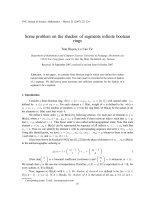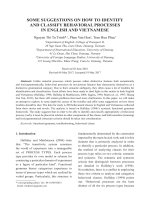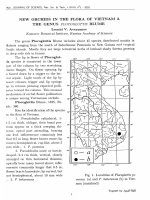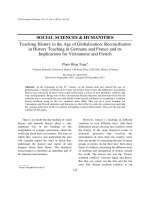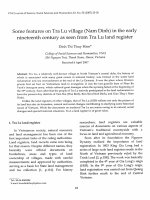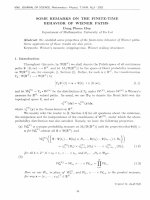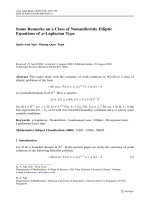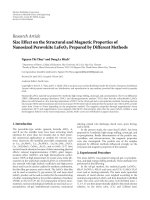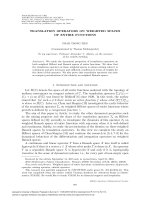DSpace at VNU: Some problem on the shadow of segments infinite boolean rings
Bạn đang xem bản rút gọn của tài liệu. Xem và tải ngay bản đầy đủ của tài liệu tại đây (838.19 KB, 4 trang )
V N U Joum al o f Science, M athem atics - P hysics 23 (2007) 221-224
Some problem on the shadow of segments inĩmite boolean
rings
T ra n H uye n, L e C ao Tu*
D ep a rtm en t o f M a th em a tic s a n d C om puter Sciences U niversitỵ o f P edagogy, H o ch im in h City
745/2A L a c L ư ng Q uan, w a rd 10, D ìst Tan Binh, H o ch im in h City, Vietnam
R eceived 18 S eptem ber 2007; received in revised form 8 O ctober 2007
A b s t r a c t . In this p a p e r , vve consider finite B oolean rings in vvhich w ere defm ed tw o orders:
natural o rder and an tilexicographic order. T he m ain result is concem ed to the notion o f shadovv
o f a segm ent. We sh all prove som e necessary and su íĩic ie n t conditions for the shadow o f a
segm ent to be a segm ent.
1. Introduction
C onsider a íinite B oolean ring: B ( n ) = {x = XỊX2..-Xn : Xi € { 0 , 1 }} w ith natural o rder < /v
defined by X
the elem ents x € B (n ) such tha t w (x )= k.
W e d e fin e a lin e a r o rd e r
B(n,k), w here X = x \ . . . x n, y = 2/1 ■■■yn, £ < 1 y if and only if there exists an index t such that Xt < yt
and Xi — yi w henever i > t. T h at linear order is also called antilexicographical order. N o te that each
elem ent X = x \ . . . x n € B (n,k) can be represented by s e q u e n c e o f all in d ic e s n \ < ... < njt such that
x n = 1. T h u s w e can id e n tiíy th e elem en t X w ith its corresponding sequence and w rite X = ịn \..., Tik).
U sing this identiíication, w e have: X = ( n 1,
t such that n t < Tĩit and Tiị = rrii if i > t .
It has been shown by Kruskal (1963), see [1], [2] that the place of element x=( n 1 ..., Tik) 6 B(n,k)
in the antilexicographic ordering is:
We rem ark that
Ihe one-one correspondence.Thereíòre
ip{A)
=
is e q u iv a le n t to A = B , fo r
every subsets A , B in B (n ,k ).
N o w , suppose a € B (n ,k ) w ith k > 1 , the shadow o f elem en t a is d e íìn e d to b e A a = { x G
B (n ,k *
1) : X
If A c
B (n ,k ),
the shadoui of A
Corresponding author. E-mail:
221
is th e Union o f a ll A
a,
a e A i.e
=
y wh
Tran Huy en, Le Cao Tu / VNU Journaỉ o f Science, Maihematics - Physics 23 (2007) 22 ì -224
222
ỊJ
Aa
= {r r G
D (n , k —1) : X
OLfo r some a
€ A } .T h u s the shadow o f A co nta in a ll the elements
X € B ( n , k - l) w h ic h can be o bta in ed b y re m o vin g an in d e x fro m the elem ent in A .T h e conception about
the shadow o f a set was used e flfìcie n tly by m any m a the m a ticia n s as:
Spem er, K ru s k a l, Katona,
C lem ent,....?
We s h a ll stu d y here the shadow o f segments in B (n ,k ) and m ake some c o n d itio n s fo r that the
shadovv o f a segm ent is a segm ent.
A s in any lin e a rly ordered set, fo r every p a ir o f elements a,b
€ B (n ,k ), the segm ent [a ,b ] is d e íĩn e d to be:
[a ,b ]= {x
e
£ (n ,
k)
:
a
< 1
X
< 1
6 }.
Hovvever, i f
a = ( l, 2 v ..? ,k )€ B (n ,k ) is the íir s t elem ent in the a n tile x ic o g ra p h ic o rd e rin g , the se gm en t’[a ,b ] is ca lled
initial segment and denoted b y IS (b ) so
u sefu l re su lt, prooĩ o f w h ic h had been g iven
an
IS ( b ) = { x € B ( n ,
k)
:
X
< 1
b}.
We re m in d here a ve ry
by K ru s k a l e a rlie r (1 9 6 3 ), see [4 ], [2 ]. We State th is as
a lem m a
Given b = ( m i,
(m 2, ...,mk) € B{n,k - 1) ?
L e m m a 1.1.
m2,
rrik)^B(n,k) wiíh k >
1
then A IS (b ) = IS(Ư), where ư
=
T h is re s u lt is a special case o f m ore general results and o u r aim in the next section vvill State
and prove those. L e t a = ( n i,7 i2 ,
and b = ( m i , 7712,
be elem ents in B (n ,k ). C o m p arin g
two indices ĩiịc a n d rrik , it is possible to arise three fol!owing cases:
(a) m k = n k = M
(b ) mic = rik + 1 = M + 1
(c ) m k > rik + 1
In each case ,we shaỉl stu d y necessary and su(Ticient c o n d itio n s fo r the shadow o f a segm ent to
bc a segment.
2
. Main rcsult
B e fo re sta tin g the m ain re su lt o f th is section, w e need some fo llo w in g te ch n ica l lem m as. F irs t
o f all, w e estab lish a follow ing lem m a as an application o f th e íorm ula (1):
Leỉ a = ( n i , ri2 ) ...í rik) and b = ( m i , m 2 ,
Tĩik) be eỉements in B(n,k) such that
m k < n. and ỉet M be a number such that rrik < M < 71. Dejìne X= ( n i , r i 2 , 7 ifc, M ) ,
i , m 2 , . . . , m k, jVÍ) eB(n,k+I). Then we have:[x,yj={c +M : c e [a,b]} and [a,b]={z -M : z €
L e m m a 2.1.
Kk
<
y = (m
fx,yj}.
(Note that here we denote X = a+ M and a = X-M )
Proof.
It fo llo w s fro m the fo rm u la (1 ) that, fo r a ny c € [a ,b ],
M
kỊ l
< ,c (c )+ ^
^ , thereíore
tp({c+M
: c € [ a , 6 ] } ) = [y > ( a ) + ^
^ ;v > (6 )+
^ ] = [v?(ar);<,ơ(ỉ/)] = v ( [ ^ ; y ] ) So [x ; y ] = { c + M : c [a ,b ]} . B y u sin g s im ila r argum ent fo r
the re m a in in g e q u a lity, vve fin is h the prove o f the lem m a.
A s an im m ed ia te consequence,we get the fo llo w in g
Let a,b £ B(n,k) be elements such that a = (ỉ ..... k-1, M) and b =(M-k+l.....
then the shadow A [ a , 6] = IS(c) with c =(M-k+ 2..... M -1M )£ B(n,k-1).
Proof Choose g = ( l, . . . , k - l) ; d = ( M - k + l, . . . , M - l) in B (n ,k - l).T h e n it fo llo w s fro m lem m a 2.1 tha t A
= { x - M : X € [ a , b ] } = [g; d ]= IS (d ). H ow ever, w e also have fro m the le m m a 1.1 that A i4 = A IS{d) —
I S ( c — M ) . R epeating to a p p ly the lem m a 2.1 to the set B ={z + M : z 6 A Ấ } . We have obtained
m uc L e m m a 2.2.
Tran Huyen, Le Cao Tu / VNU Journal o f Science, Malhemalics - Physics 23 (2007) 2 2 ì -224
(p(d) + 1
b] — A u B = IS (d ) u
tp(h)
B = [h ;c ] vvhere h = (l,...? ,k -2 , M ). N o te tha t
=
T h e re íò re th e ir U nion: A [a ;
Ị / i; c ] =
223
so A and B are tw o co n se cu tive segments.
IS (c )
is an in itia l segm ent. T h e p ro o f is
co m p lete d . We n o w get some u se fu l consequences o f th is le m m a as fo llo w s :
Let a = { n \ , n /c - 1 , M ) and b=(M —k + 2 , M, M + 1) be elements in B(n,k) then
=IS(c) with c =(M - k + 3 , M, M + 1 )€ B(n,k-Ỉ).
C o r o lla r y 2.1.
A Ịa ,
6
Proof.
]
C hoose d = ( l,. .. ? , k - l, M + l ) e B (n ,k ) then [d ; b ] c
= IS (c ) w ith c = (M -k + 3 ,...? , M , M + l ) e B (n ,k -1 ).
A
IS(b)
=
IS{c).
T hus A [ a ,
6
[a ;b ].B y the lem m a 2.2, vve have A [ d , 6 ]
H o w e ve r, w e also have: [a ,b ]C lS (b ) so A [a » *ỏ ]c
] c A ( 6 ) = IS (c ) as re q uired .
Let a =(l,...?,k-ỈM ); b = ( m i , M
+ 1) be eỉements in B(n,k) then A ịa , 6 ]
=IS(c) where c ={m 2 ,...,771*1-1, A / + l ) e B(n,k-Ỉ).
Proof. In the p r o o f o f th is re su lt, w e denote: h = ( M - k + l,...? ,M ) € B (n ,k ), đ = (M -k + 2 ,...? ,M ),
g = (l,...? ,k -2 , M + l ) , c = ( m 2 , M
+ 1) in B (n ,k -1 ). T h en ,again b y the le m m a 2.2, w e
have: A [ a , h} = IS(d)C A [ a , 6 ]. O b v io u s ly , w e also have [ g ; c ] c A [ a , 6 ]. T h e re fo re , A [ a ; 6 ) D
ự s { d ) u [5 ; c]) = IS (c ) and as in above p ro o f it fo llo w s th a tA Ịa , 6 ] = IS (c ).
C o r o lla r y 2.2.
2.ĩJLet a = ( n i , n 2 ,
Tik) andb = ( m i , 7 7 1 2 , rrik) € B(n,k) begiven such that m k > nfc + 1
then A Ị a , 6 ] =IS(c) where c = ( m 2 ,
mù) 6 B(n,k-1).
Proof. S ince rrik > rifc + 1, there m ust be a n u m b e r M such tha t nic + 1 < m/c - 1 = M. Choose
C o r o lla r y
d = ( l, . .. ? , k - l, M ) £
B (n ,k ), w e the re fo re have [ d ; b ] c
[a ;b ].
N o te that the segm ent [d ;b ] sa tisíys
c o n d itio n s o f c o ro lla ry 2.2, w e n o w im ita te the above p ro o f to fin is h the c o ro lla ry. C e rta in tly , the last
c o ro lla ry is a s o lu tio n fo r o u r ke y questions, in the case (b ). W h a t about the re m a in in g case ? F irs t o f
a ll, w e tu m o u r a tte n tio n to the case (a) and have tha t:
Let a,b e B(n,k) be elements such that a = { ĩ i \ , n fc _ i, M ) andb = ( m i , TTik-1 , M )
then A [ a , 6 ] is a segment if and only if m \ = M - k + 1and either Tik- 1 < M — \ or nic- 2 — k —2
Proof. T ake c =a - M ; d = b - M e B ( n , k - l) then A [ a ; b} = [c; d] u { x + M : X e A [c , d]}. Suppose tha t
A [ a , 6 ] is a segm ent then there m u st have g = ( l, . . . ? , k - l) € A [ c ; ể ] and v?(cỉ) + l =
A [ a , 6 ] so h = (l,...? ,k -2 , M - l , M )G [a ,b ]. T h e re ío re , a < h. H o w e ver, rik- 1 = M - 1 fo llo w s tha t
h = ( 1 ,? , f c - 2 ,
< ( n 1 , . . . , n fc- 2 , M - 1 , M ) — a . T h u s a = h , i.e, n k - 2 = k - 2. C onversely,
T h e o re m 2 .1 .
suppose th a t a = ( l, . . . ? ,k - 2 , M - l, M ) and b = ( M -k + 1 ,...? , M - l , M ). We sh a ll prove th a t A [ a , 6 ] is a
[ a - M , b - M] = IS (c ) w here c
= ( M -k + 2 ,...? , M - l ) . We n o w have A [ a ; 6 ] = [a —M ] b - M ] u { x + M : X 6 IS(c)} to be the Union o f
tw o co n se cu tive segments. T h e re fo re ,it is a segm ent. In the case rik-i < M — 1, a p p ly the c o ro lla ry
2.1 ( i f Uk-I = M - 2 ) o r the c o ro lla ry 2.3 ( i f n jt _ i < M - 2 ) to the segm ent [a - M ; b - M ] w e o b ta in
A [a-M , b—M\ = / 5 ( c ) fo r s o m e c € B (n , k -2 ). T h u s A [ a ; 6 ] = [a —M \ b -M ] u { x + M : X € / S ( c ) }
segm ent. A p p ly the lem m a 2.2 to segm ent [a -M ; b - M ], w e o b ta in A
as above is the U nion o f tw o co nsecutive segm ents, the re íò re is a segm ent.
F in a lly , w e re tu m a tte n tio n to the case (b )w ith
mi : m i = M - k
+ 2 and
m\ < M - k + 2
mic = Tik +
1. T h ere are tw o a b litie s fo r in tịe x
. T h e fo rm e r is e a sily answ eređ b y the c o ro lla ry 2.1 so
hcre w e o n ly g iv e the p ro o f fo r the la tte r.In fact, We d e fm e the n u m b e r s as fo llo w s
s = m i n { t : m k-t < M — t}
We close th is section vvith the fo llo w in g theorem :
2
Tran Huyen. Le Cao Tu / VNU Journal o f Science, Mathematics - Physics 23 (2007) 2 2 ì -224
224
I f a = ( n i,
then we have that:
M ) and b = ( m
T h e o re m 2 .2 .
k
+
1
.
(a ) In
th e c a s e T ik -S
+1 <
M
-
s +
1, A[a, 6]
(b) In the case Tik-s+ 1 = M — s + \,
a n d e ith e r
T ĩk -S
<
M
— s o r r ik -s -1
=
A [a ,
k — s — ĩ
6
]
i , M + 1) €
is a s e g m e n t.
is a segmení if and only if
w here a
'= ( n i ,
T ik -S
)
+
1
ố ’= ( m i , m * _ s ) €
and
B(n,k-s).
Proof. Choose h = ( M - k + l, . .. , M - l ) ; c = a -M ; d = b - ( M + l) € B (n , k -1 ) and d e fin e set x = { y + (M +
1) : y e A IS {d )}. Since [a ;b ]= [a; h + M ] U { x + ( M + 1) : z e IS{d)}. W e have A ( a ;ò ] =
IS(d) u A [ a ; / i + A í] u X . N o te that tw o mem bers IS (d ) and X o f th is u n io n are segments and
<^(m ax A [ a , / i + M ] ) + l = ( ,ỡ (m in X ) so A [ a , 6 ] is a segm ent i f and o n ly if t h e Union IS (d ) U A Ịa ; h+M)
is a segm ent. In the case tha t Tik-s+ 1 < M - s + 1, there m ust be g = (l,...J k -s , M -S + 1 ,...,M ) 6 B (n ,k )
such th a t g € [a ; h + M ]. D enote g ’ = (l,...? ,k -s , M -s + 1 ) and h ’ = ( M - k + l, . .. , M - s , M - s + l) e B (n , k-s+ 1 ). B y
le m m a 2.2, w e o b ta in an in itia l segm ent. T h e re ío re the set Y deíìned b y Y = { 2 + ( M - s +
A[< 7 ', / i '] } is a segm ent in B (n , k-1 ). ít is easy to see that d = ( m i ,
th is fo llo w s
th a t IS (d )
rrik-s, M - s - 1
2
,
M) : z€
- 2 , M ) e Y and
u Y is also a segment. T h u s, It is cle a r that IS (d ) u X = IS (d ) u Y is a segment
m k- 1 < M — 1 ,
d = b - (M + 1) < h in B (n , k -1 ). N o te tha t A[a;h + M ] = [c; h] u {z + M : z € A Ị c ; h]}, thereíore
I S ( d ) U A [a ; / i + M ] is a segm ent i f and o n ly i f ự>(c) < ự>(d) + 1 and A [ a , / i + M \) is a segment.
A c c o rd in g to the theorem 2.1, last c o n d itio n is equavalcnt to that ĩĩk - 1 < M - 1 o r n jt _ 2 = k - 2 is
required. Next, suppose that s> 1 with Uk-s+1 = M- S + 1 then a = ( n i , n/c-s, M - s + 1 | •••) M)
and d = ( m i,
M — s + 2 , M ). Take
as re q uired .
In th e case
rik- 3+
1
=
M - s
+ 1 , w e consider fir s t s = 1 . Since
À = { x + ( A / - s + 2 , M ) : i e Á[a' + ( M - S + 1 ) ;
and h ’ = ( M - k + l,...,M - s ) e
and o n ly
( m
if
the u n io n IS (d )
i , m k - 3) <
2
\JA
, where a ’= ( n i ,
U k-
3)
It is clear that the Union IS (d ) u A [ a ; / ỉ + M Ị is a segment i f
is a segm ent.
N o te that
mfc - 3
<
M - s,
therefore
b' —
h ' . H e n c e , th e la st r e q u ir e m e n t is e q u iv a le n t to th e re q u ir e m e n t th a t ip ( a ') < i p ( b ') + l
and A [ a ' + ( A / - S + 1 );
the theorem
B (n ,k -s ).
h ' + ( M - s + 1)}}
h' + ( M - s + 1)]
= Ịa '; / i ' ] u { y + ( M - s + l ) : y € A [ a '; / i '] } is a segment. B y
. 1 , the la tte r is e q u iv a le n t to the requirem ents tha t nfc_s <
M —s
or
rik- 3 - 1 = k - s ~
1
.
T h e p ro o f is co m p lete d .
References
[1] I.Anderson,Combinatorics o f JInìte sets, Clarendon Press, Oxford, (1989).
[2] B.Bolloba? Combinatorics, Cambridge University Press, (1986).
[3] G. o . H.Katona, A ứìeorem on ílnite sets. In Theorỵo/Graphs. Proc. Colloq. Tihany, Akadmiai Kiado. Academic Press,
New York (1966) pp 187-207.
[4] J. B. Kniskal, The number of simpliccs in a complex, In Mathematicaỉ optimization techniques (cđ. R. Bcllman ),
ưnivcrsity of Calíomia Press, Bcrkcley (1963) pp 251-278.
